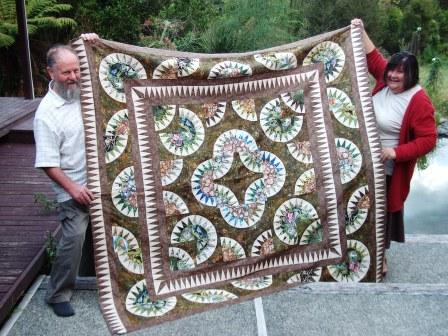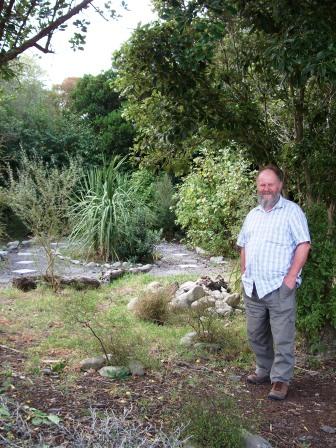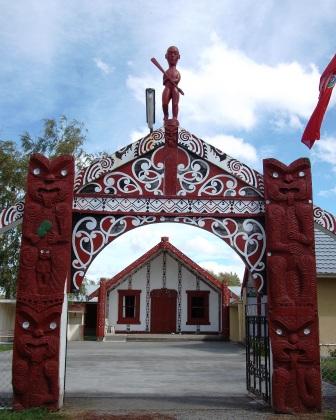Yes, perhaps one day they’ll decide to have another kid and adopt ME! (Oh, to dream…)

The Fields with Jean's latest NZ ecology quilt! Every time I looked at it I saw some new creature of beauty.
Warren is a bounding soul with creative and positive energy that pours out into everything he does: from his work with students of nature, to his discussions with friends, care of his farm animals, joy of music, local art and rugby, studies of NZ reptiles, plans to be with his grandson, meals with his wife, and love for the Ruamahanga River and it’s eels. Warren is one of those rare men you meet who puts his all into everything he does… and encourages those around him to give their best as well.

Warren in front of a lizard garden he helped students make at their school. There is even an underground passageway for the scaly ones to cross a path without birds spotting them!
Several times, Warren, Sam Ludden and I found ourselves speaking of eels and some unexplainable artery running through our ihi as we’d find ourselves tearing up as we spoke. The ihi is that feeling inside… that connection to life and soul… that makes you get goosebumps and pulls you at your core. I felt it a few years ago at the Mouraki Boulders when I watched the river run into the sea and knew I had to come back to NZ for some reason having to do with water. Sam feels it whenever he recalls that big female longfin he looked at in the eye, deep underwater in a hinake (eel trap).

This is one half of an eel carving at Papawai marae. The other half is at Manga Kino; the township created as repayment for the taking of Wairarapa Moana (lake).
Warren knows it when he tells about Elly, the big old female eel with a torn pectoral fin that he cared for for many years. One fall he noticed that her head was tapering to prepare for her long heke (journey) out to sea to mate and die. The day he went down to feed her as usual and she did not appear he just cried… with sadness that she was gone and with hope that she would make it all the way back to Tonga. I feel it now just typing about these amazing fish of river and open ocean.
Warren and Jean generously shared with me many meals, cold beers, thoughtful conversations, and even their corner exercise bike. From their stories I learned much about the history of the Wairarapa area. Including one of my favorite images: According to Jean, local Maori women practiced their own form of passive resistance back when settlers were first digging a trench to keep the moana (lake) open to the sea in order to stop the seasonal flooding of the lake’s natural wetlands; wetlands then newly claimed as farmland by the Crown. The Maori’s way of life and winter food stocks depended upon the spit between lake and sea closing up each fall when the migrating eels arrived, as that was the time for and method of their annual eel harvest.
To prevent the pakeha (others) from digging the trench, the women went down to where they were digging and peacefully embraced the men so as to keep them from using their shovels!
Before sending me down the gravel road to catch a glider flight, Warren told me about how the Maori from the nearby Papawai marae (the place of New Zealand’s first parliament, by the way) were known for being early engineers of glided flight via man-driven kites. He explained how all the carved statues around the marae face inwards to indicate peace, with the exception of one at the Eastern corner who faces out towards the Southern hills.
This carving represents the man, Nuku- pewapewa, who made and perhaps glided the kite from those hills in order to open the gates for the warriors who were waiting to attack an enemy pa. I must say, I felt just like a kite as I was being towed by a little car as I lifted straight up into the sky!
Perhaps the most gracious Warren and Jean shared with me was to allow me to be formally welcomed into Papawai marae. As one of the most beautiful women I’ve ever met (beautiful because of her glowing, easy smile, and open face and arms) explained: now that I’ve been welcomed there, a part of me will remain there. Indeed it will. When Papawai marae, with the expert sewing skills of Jean, create their section of the tapestry, I think I’ll recognize that one as my own somehow.

The historically important Papawai marae, as this was one of the first regions in New Zealand settled by people.
The marae also welcomed the kids and teachers from Kuranui College who were taking a 3-day river heke to follow the eels migration and to record the quality of the river’s mauri (ecological and spiritual health) as they traveled from the mountains to the sea.
I was greatly impressed with those kids and how hard they worked each day, although I was not able to join them. Sam and their teachers, especially Gina, are strong and caring leaders with who see the wonderful power and possibility within those kids. The kids’ heke and a brief nod to the tapestry appeared on NZTV! Here, check out Chapter 2: http://tvnz.co.nz/te-karere/2010-thursday-video-983401
My last week in the Wairarapa gave me much inspiration to take back and apply to kids in the desert. I really want to get them outside and experiencing nature….. getting an awareness of their own ihi and it’s need for things and places things wild.





